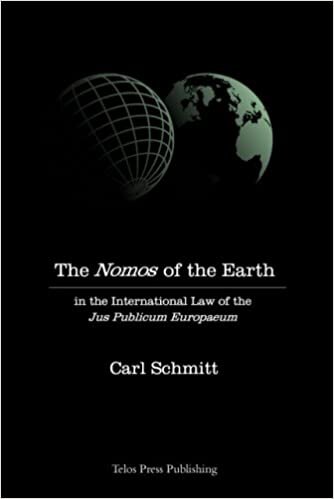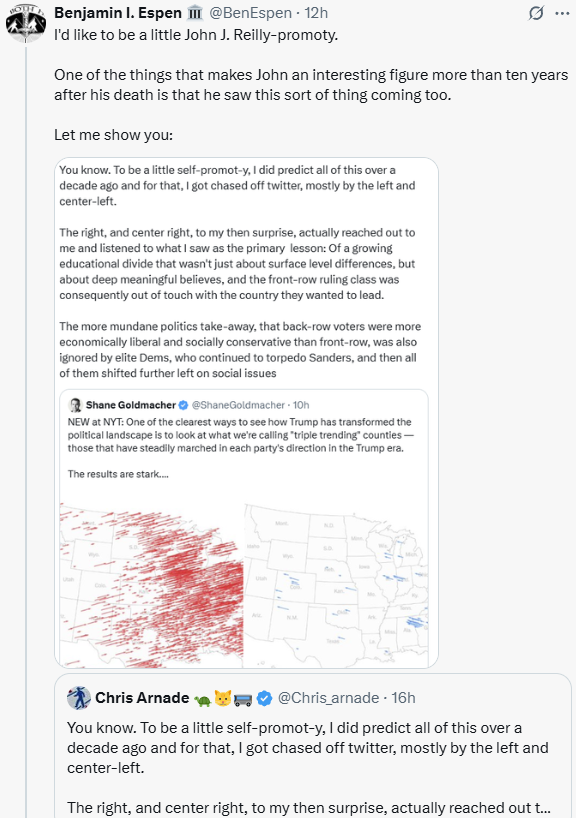The Long View: The Nomos of the Earth
Among the few who know who he is, Carl Schmitt doesn’t have a good name, since he had the temerity to provide intellectual justification for the Nazis. However, it would be a mistake to dismiss Schmitt, as this book review offers a cogent explanation of how the world got so messed up in the twentieth century. The Nomos of the Earth [Amazon link] also offers us a clear view of what direction global politics might take in the twenty-first.

The Nomos of the Earth
in the
International Law
of the
Jus Publicum Europaeum
By Carl Schmitt
Translation & Introduction by G. L. Ulmen
Telos Press Publishing, 2006
German Original 1950; 2nd Edition 1974
372 Pages, US$34.95
ISBN-10: 0914386301
Carl Schmitt (1888-1985) was a German jurist who bears comparison to Heidegger both in eminence and biography. He was one of those respectable intellectuals of the Right who offered their services as an ideological clarifier to the Nazi regime, only to find that the Nazis really were not much interested in clarity, or at least not in any clarity that Schmitt was equipped to provide. He is best known in the English-speaking world for his definition of the sovereign as the agency with the authority to make an exception, for the ability of the sovereign to designate an "enemy," and for the principle that sovereignty is defined by the Ernstfall, the emergency case at the point where a concrete decision is made.
Schmitt was an anticonstitutionalist, meaning he tended to regard written constitutions as epiphenomena, but by no means a nihilist. The last point comes through very strongly in this book, The Nomos of the Earth [Amazon link], written in Berlin during the Second World War. (This edition contains an Appendix written during the early 1950s, plus the translator’s useful introduction.) As the translator suggests, though the text nowhere says so explicitly, The Nomos was originally intended to formulate the theoretical basis for a German Grossraum in Europe, a sphere of influence analogous to the Monroe Doctrine’s demarcation of the Western Hemisphere for the United States. The book we actually have, however, is a description of the Eurocentric, global system of international law that developed after the discovery of the New World, and that Schmitt argues, with some reason, ended at the beginning of the 20th century.
This book contains what must be some of the most hilarious assertions in the history of jurisprudence. Thus, we learn that the Belgians were the ones who finally destroyed the public international law of Europe, and that the 18th-century partition of Poland was systemically appropriate because the Polish government did not exercise sufficient control over its territory to constitute a state. Nonetheless, the book is valuable for its clear exposition of the thesis that the nation is an entity that makes sense only in a larger legal context. Indeed, at this writing, the book is topical: its outline of the future nomos of the planet as a choice among world government, maritime hegemony, or multiple Grossräume is pretty much the set of choices that we find in geopolitical assessments today.
“Nomos” is a Greek word universally translated “law” in English, “lex” in Latin, and, usually, “Gesetz” in German. Schmitt takes issue with these equivalences, and especially the last. “Gesetz” smacks of the merely positive, statutory, written law that he believed it was the business of jurisprudence to dig beneath in search of the real law. Underneath the modern and Hellenistic understanding of nomos as mere law, according to Schmitt, we find a meaning like the English term, “radical title.” That is the possession from which all later possession derives, and which on the historical level means the terms on which land originally entered the legal structure of the community. The nomos of a territory, then, is the terms of its original appropriation, its taking. Schmitt points out that the word is cognate with the German “nehmen,” “to take.” He then goes further and suggests, but does not attempt to prove, that nomos is connected with “Name” (same meaning and spelling in German and English, but pronounced “nahmeh”), so that to take a territory is to conceptualize it. This, he concludes, was the real jurisprudential basis for the European appropriation of the New World.
Before the Age of Discovery, there was no global law of the earth. Each civilization might have a history, and even an established procedure, for dealing with its barbarous and civilized neighbors, but each such relationship was ad hoc. Within the West, there was a sophisticated civil and ecclesiastical law to regularize the wars and other dealings of princes, republics, and the Church, even though the modern notion of the state did not exist. Medieval Europe was anarchic, but by no means lawless. The Holy Roman Empire enjoyed a sort of preeminence in the system, but Schmitt says its ideal characterization as a universal sovereign was an aspect of late medieval theories about the “perfect society.” (The Church was supposed to be the other perfect society.) Rather, Schmitt lays emphasis on the early identification of the Empire as the “katechon,” the “Restrainer” of Antichrist mentioned in II Thessalonians 2:6–7; the end of the Empire would be the end of the age.
The public law of modern Europe was continuous with medieval law, but developed through a process in which moral and theological content was drained from earlier jurisprudential concepts, leaving only a formal structure. Schmitt evinces a great respect for the early Spanish jurists, who dismissed the arguments that the Spanish conquests in the Americas could be justified by a grant from the emperor or the pope, or even by the right of discovery. The indigenous peoples had human rights to life and property that European sovereigns could not wantonly abrogate. The conquest of the Western Hemisphere was based on just wars nonetheless, however, because they were in the service of an evangelical crusading enterprise authorized by the pope. The Spanish and Portuguese had to exercise effective government in the west in order to facilitate the free commerce and travel on which missionary activity depended. This was one origin of the concept of the “freedom of the sea.”
The other was the right to piracy, which was more congenial to the English temperament. Famously, in the early 16th century, the pope brokered a global division of the Spanish and Portuguese spheres of influence with a raya, or line of longitude, that ran north to south through the whole earth. The English version of this was the “amity line.” On the hither side of an amity line, the ordinary usages of polite nations applied; European treaties were observed and the private property of all travelers was respected. On the nether side was the war of all against all. This could be limited by particular agreements among the parties, but the rule was that, on the high seas and on non-European soil, the rules did not apply that applied in Europe.
The purpose of both the rayas and the amity lines was the purpose of all international law, at least in Schmitt’s view: not the prevention of war, but the bracketing of war. A clash on the border between two European states was an act of war. A clash at sea or between colonies need not be. Conversely, war in Europe need not mean war in the colonies. Starting in the 16th century and extending even into the twentieth, the colonial situation was an anticipation of the dictum, “Whatever happens in Vegas, stays in Vegas.” We should note that, sometimes, Schmitt characterizes this extra-European regime as “international law” properly so called, and contrasts it with the “European public law” that governed the states of Europe. Literally, of course, the latter is an “international law,” too, and Schmitt sometimes uses the term in a pre-twentieth century European context, as we see in the book’s extended title.
Within Europe, the public law of Europe in the 16th and 17th centuries used old concepts to bracket conflict. The early modern wars of religion were wars of “just cause,” fought against enemies regarded as criminals whose destruction was a war aim. Neutrality was not an established institution. Societies were targeted as well as militaries. By the middle of the 17th century, however, European jurisprudence had ended this unsatisfactory situation. The concept of “just war,” in the sense of legally recognized war, was not abandoned, but it became a purely formal question of legal sufficiency. The notion of “just cause” for war was relegated to the conscience of the belligerents. There was no discrimination between aggressive and defensive war. The public law of Europe was concerned only with whether the combatants were “just enemies,” a category that was increasingly limited to states. (The later “nation state,” the state that represents a people, was a refinement of legitimacy that had surprisingly little effect on the viability of the international system.)
The state was not a new idea, but it developed a new significance in this period. It absorbed every kind of civil and religious authority that had hitherto existed in the lawful anarchy of medieval Europe. Among the things it absorbed was the monarchies (a point that was missed, it seems to this reviewer, by some of the dimmer monarchs, who did not realize that their absolutist governments were displacing them). The state was reconceptualized as a person, as an active will, that might enter into duels with other, similar persons, provided the duels conformed to certain recognized forms. In a sense, each state was independent of every other, but the independence was bracketed by understandings with its neighbors. Neutrals were recognized to be interested parties to peace treaties, for instance, because each part of the European public space depended for its security on a balance of power, indeed a balance of consensus, among the Great Powers. And of course all of Europe understood that its internal rules did not apply at sea or in the colonies, except to the extent the Great Powers agreed they did. Wars were not fought against civilians or civilian infrastructure. For that matter, during an occupation, the civil law of the state from which the land was taken still applied. Territory that had been generally recognized as neutral would stay neutral when it changed hands.
The absolute state was tolerable because its claims were limited. All of Europe had a roughly comparable system of secure property and liberal economics. When one state occupied another’s territory, or even annexed it, there was generally no political or social revolution, except to a limited degree during the Napoleonic era. Treaties of peace were understood to include amnesties for the participants on both sides.
On the border of this system was England, which had developed in such a way that the state was subordinate to society. Economics and trade were the objects of English statecraft. England’s chief function in the Eurocentric international system was the maintenance of the law of the sea, which was essentially a system for bracketing “prize war,” the war of taking booty. England was of Europe but not in it. Be that as it may, England’s relationship to Europe was less ambiguous, or perhaps less extreme, than that of the United States.
We should note that Schmitt’s understanding of American (in the sense of the US) law was perhaps impeded by interruptions in library hours during the period when this book was written. Still, we should note that, in discussing American constitutional history, he mentions “The Declaration of Human Rights” of 1775, a document that has escaped this reviewer’s notice. (One surprising point: Oliver Wendell Holmes’s “realist” view of law is wholly positivist but still similar to Schmitt’s Ernstfall: nonetheless, Holmes is mentioned only in a footnote.) In any case, Schmitt makes two chief points about the United States.
The first is that, from the time the US became prominent in global affairs, it has applied a principle of foreign affairs derived from Washington’s Farewell Address: “As little politics as possible; as much trade as possible.” In international relations, this means that Americans, and even American diplomats, are usually present when important decisions among the great powers are made, but the American government tends to refuse to take responsibility for political (and economic) decisions that it has influenced. This pattern of presence-and-absence was true of the Congo Conference of 1885, which Schmitt characterizes as the last great act of the European system. There, the US helped to set the terms for neutralization of Central Africa but declined to guarantee the settlement. Famously, the US was present at the Conference of Versailles but refused to ratify the treaty. One might ad that the US helped draft the Kyoto Protocols and then refused to be bound by them (though one may also note that the US actually complied with the terms of the agreement, unlike many of the signers).
The other point is that the US, quite early in its history, sought to make the Western Hemisphere a peculiar region of international law, an American Grossraum. The charter for this sphere of influence was the Monroe Doctrine of 1823. The motive was not that the United States did not consider itself part of the West; on the contrary, the US tended to consider itself the true West, to which Europe was an archaic and degenerate prelude. The Western Hemisphere, under the Monroe Doctrine, thus became the hither side of an amity line, the side on which progress and peace were possible. The other side was consigned to chaos and Old Night.
But sometimes not. Schmitt asserts that the US was a nation of the Calvinist elect that was also a missionary enterprise. He notes that the notorious Calvinist, Woodrow Wilson, wanted the League of Nations headquarters to be placed at Geneva. (Curiously, Schmitt does not note how this characterization dovetails with the Spanish justification for the appropriation of the West.) The American impulse to quarantine the reprobate to the shabby side of the planet was always strong, but not in the long run as strong as the impulse to redeem them through the projection of American ideas of good international governance. Being theoretical, these ideas necessarily took the form of rootless universalism. Readers may infer that this impulse was facilitated by the limited importance of the state in American international relations. Hegel, we are reminded, had said that there was no American state, and Schmitt seemed to think that this assessment was still true in his own time. Far more even than was the case with England, American society became present in regions from which the American state was absent, or at least absent at first.
“International law” in the modern sense began to be introduced into Europe at the end of the 19th century. It decentered Europe from the global system, and at the Conference of Versailles, it destroyed European public law. As an example of the transition, we have already noted the nefarious Belgians. At the Congo Congress, the Congo Free State was created by the Great Powers as an independent entity, under the unfortunate rule of the Belgian King Leopold. Its neutrality was recognized by a collective act of Europe, in the same way that the permanent neutrality of Switzerland had been recognized at the Congress of Vienna, and as Belgium’s own neutrality had been recognized a few years later. In the early 20th century, however, when the Belgium state assumed direct control of the Free State, it refused to accept recognition by the Great Powers as the basis for its sovereignty. Rather, Belgium based its claim on “effective occupation.”
You see the distinction. The public law of Europe did not promise much, but what it did promise it could usually deliver. The recognition of the Great Powers was a concrete fact in which some confidence could be placed. In contrast, the international law theory of “effective occupation” was just that, a theory; essentially a debt that no one in particular was obligated to pay. You can see why the 20th century became unhinged. The law of the outer world, of the world beyond the amity lines, was introduced into Europe, so that the same rule applied on the Rhine as on the Congo. In neither place did it work well.
International law had the effect of destroying the bracketing mechanisms that had been the great achievement of European jurists. The concept of “just cause” was reintroduced, largely as part of the effort to criminalize war in general. The status of “just enemy” was distorted beyond all recognition. It was stripped from states that would previously have remained parts of the international system and accorded to rebels and revolutionaries. Heads of state became subject to prosecution for war crimes, without possibility of amnesty. Wars once again became wars to the death for entire societies. To lose a war was to risk forcible inclusion into a culturally and legally alien universe.
Clearly, the old nomos that had begun to gel in the 16th century had passed away, and something new would have to replace it. Regarding the coming nomos, as we have seen, Schmitt offered three options. The first was some genuinely universal system, a world government in fact if not in name. He mentions the possibility several times, but offers no specifics: this is clearly not his favorite choice. The option that would entail the least change from historical experience would be an augmented version of maritime hegemony. Under this option, some power, probably the United States would do pretty much what the Britain of Queen Victoria’s day did, but with the addition of air power. The third possibility, and perhaps the one Schmitt finds most congenial, would be a plurality of international systems. This is what today we would call “multipolarity.”
At least in this book, Schmitt offers few clues about which possibility is the most likely. In a way, this is to be welcomed. Schmitt’s brand of jurisprudence is not to everybody’s taste, but at least it is not bossy, unlike the legal theory that attends early 21st century transnationalism. Actually, the problem with it is that it is too willing, even eager, to be bossed. Perhaps anyone who consults Schmitt about the creation of a new nomos should come away with this useful piece of advice: to name is to take.
Copyright © 2008 by John J. Reilly
Support the Long View re-posting project by downloading Brave browser, and then trying it out. With Both Hands is a verified Brave publisher, you can leave me a tip too!



Comments ()